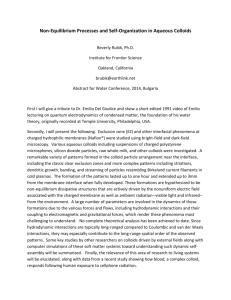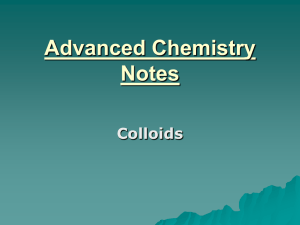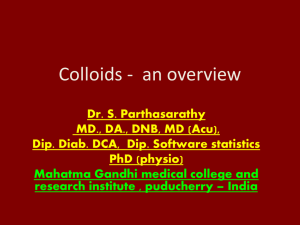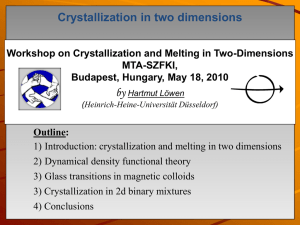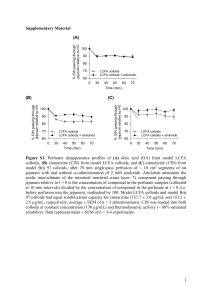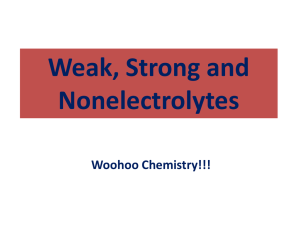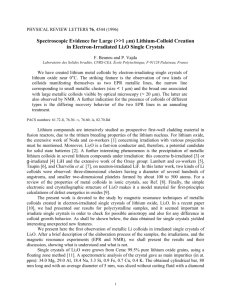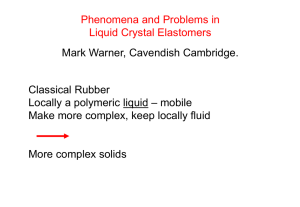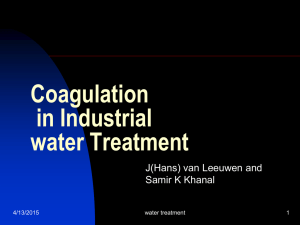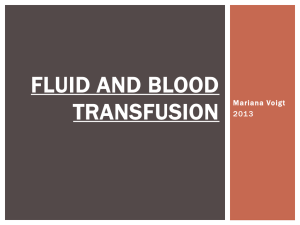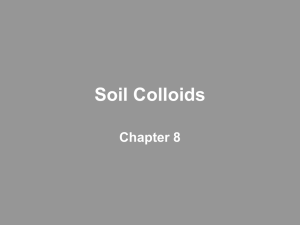Electric-field induced phase transitions, dynamical states and non
advertisement
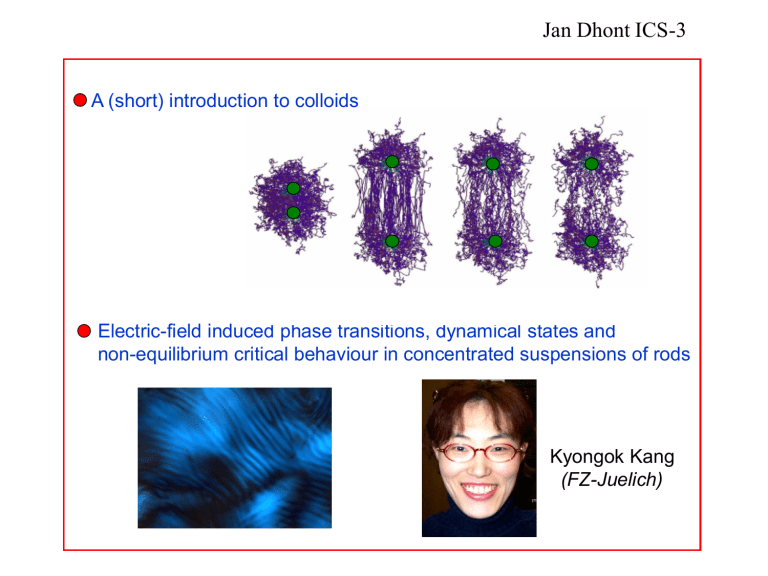
Jan Dhont ICS-3
A (short) introduction to colloids
From David pine’s webpage
Electric-field induced phase transitions, dynamical states and
non-equilibrium critical behaviour in concentrated suspensions of rods
Kyongok Kang
(FZ-Juelich)
Introduction to Colloids
What are Colloids ?
Colloidal particles are “aggregates” with linear dimensions in the size range of
1 nanometer – 20 microns
colloids are much
larger than fluid molecules
“Brownian
motion”
colloids exhibit vivid
thermal motion
“hydodynamic interactions”
sphere diameter 500 nm
Introduction to Colloids
What are Colloids ?
Colloidal particles are “aggregates” with linear dimensions in the size range of
1 nanometer – 20 microns
water molecules
colloids exhibit vivid
thermal motion
colloid
sphere diameter 500 nm
Introduction to Colloids
What are Colloids ?
Colloidal particles are “aggregates” with linear dimensions in the size range of
1 nanometer – 20 microns
water molecules
colloids exhibit vivid
thermal motion
Brownian motion
is nothing but thermal motion
colloid
Same laws of Thermodynamics and Statistical Physics
Phase transitions
You don’t have to learn anything new to understand colloids
(in principle)
sphere diameter 500 nm
Direct interactions can be tuned “at will”
V(r)
-- -- - - - - - - - - - --
r
Crystallization (FCC)
Glasses
Liquid-gas coexistence
Aggregation
Gels
Crystallization (FCC and BCC)
Electric fields
Crystallization of “hard spheres”
P.N. Pusey, E. Zaccarelli, C. Valeriani, E. Sanz, W.C.K. Poon, M.E. Cates,
Phil.Transactions A, 367, 4993 (2009); arXiv:0908.1663v1 [cond-mat. Mtrl-sci]
“sticky spheres”
binodal
fluid
gel
spinodal
(taken from Eric Weeks webpage)
H. Verduin, J.K.G. Dhont, J. Coll. Int. Sci. 172, 425 (1995)
Mixture of charged and uncharged colloids
- - - - -- - - - -- - -
NaCl-type crystal
--
-
-
NiAs-type crystal
M.E. Leunissen et al., Nature 437, 235 (2005)
Other shapes : rod-like colloids
fd virus : L = 880 nm
D = 7 nm
P = 3000 nm
Mixtures of rods and spheres
Sphere diameter 100 nm
Rod length
900 nm
Adams et al., Nature,1998
disks
patchy colloids
F.M. van der Kooij, M. Vogel, H.N.W. Lekkerkerker, Phys. Rev. E 62, 5397 (2000)
from David Pine’s webpage
star-like polymers
(like DNA-colloids)
From David pine’s webpage
transient, non-equilibrium forces
Electric double layer / layer of condensed ions :
1 nm-10 micron
minimization of
F=U -TS
-COO-COO-COO-
dissociation : high S
high U
H+
H+
-COOH
-COOH
-COOH
no dissociation : low S
low U
H+
H+
H+
H+
-COOH
-COO-COOH
H+
H+
H+
H+
H+
H+
H+
H+
H+
charge density ~ exp{ r}
r
Debye length
screening length
1 ~ 1 / salt concentration
Electric double layer
thin layer of “condensed” ions
diffuse electric double layer
Electric-field induced phases, dynamical states , and critical behaviour
in suspensions of rod-like charged colloid
At sufficiently low frequencies (< 10 kHz) :
- double layers are polarized
- the layer of condensed ions is polarized
- field-induced association-dissociation
of condensed ions
- electro-osmotic flow is induced
E
Field-induced colloid-colloid interactions :
- electrostatics
- hydrodynamics
fd virus : L = 880 nm
D = 7 nm
P = 3000 nm
- 0.16 mM TRIS/HCl buffer (Debye length is 27 nm)
- fd concentration is 2.0 mg/ml = within the isotropic-nematic two-phase region
- At high ionic strength, the nematic phase is a cholesteric
E
[V/mm]
6
4
H
D
N*
2
N
0 0
10
1
10
2
10
3
10 [Hz]
Concentration : 2.0 mg/ml
= 26 c*
two-phase, isotropic-nematic coexistence
function generator
L = 1.5 mm
light
source
polarizer
analyzer
isotropic
G
10 x
sample
DIC
CCD
nematic
K. Kang, J.K.G. Dhont, Soft Matter 6, 273 (2010)
200 micron
E
[V/mm]
6
Nematic + Isotropic
4
H
D
N*
2
0 0
10
N
1
10
2
10
3
10 [Hz]
a chiral nematic is also found
at high ionic strengths
and at higher f-concentration
without an electric field
E
[V/mm]
6
Nematic + Chiral-nematic
4
H
D
N*
2
0 0
10
200 micron
N
1
10
2
10
3
10 [Hz]
Uniform homeotropic alignment
E
[V/mm]
6
4
H
D
N*
2
0 0
10
200 micron
N
1
10
2
10
3
10 [Hz]
Uniform homeotropic alignment
order parameter (S=0.48) and
diffusion coefficients are
independent of field strength
and frequency
E
[V/mm]
6
4
H
D
N*
2
0 0
10
N
1
10
2
10
3
10 [Hz]
200 micron
no charge-polarization
Melting and forming of nematic domains
E
[V/mm]
6
4
H
D
2
0 0
10
200 micron
N*
N
1
10
2
10
3
10 [Hz]
Origin of the dynamical state:
association of
condensed ions
E0
decay towards
the isotropic
state
(iii)
(ii)
aligned state is
unstable
decrease of
ionic strength
rotation of the
director towards
the external field
increase of
ionic strength
dissociation of
condensed ions
(iv)
de-aligned state is
meta-stable
or unstable
(v)
orientational
order increases
(i)
6
4
2
0 0
10
1
10
2
10
3
10
Critical behaviour:
- Domain size diverges
- Characteristic time
for melting/forming
diverges
E
[V/mm]
6
4
H
D
N*
2
0 0
10
200 micron
N
1
10
2
10
3
10 [Hz]
I
6
4
2
t
“video-image correlation function”:
0 0
10
1
10
2
10
3
10
1.0
CV
0.8
CV (t )
( I (t ) I (t ) ) ( I (0) I (0) )
( I (0) I (0) ) 2
t
CV (t ) exp
characteristic time for melting/forming
0.6
3.26 V/mm
0.4
3.78
0.2
0.0
4.09
5.77
0
10
20
30
time [s]
E
: power-law
: power-law
E 1.39 0.18
d : power-law
dE 1.29 0.15
0.65 0.15
d : logarithmic
: logarithmic
d : finite
H
D
N*
Polarization for parallel orientation only important when :
frequency of the
external field
L2
1 1 kHz
D
D
time to diffuse
over the length
of the rod
diffusion coefficient of
salt ions
Hydrodynamic interactions are instantaneous when :
Long rods :
L 1
specific mass
L2
1 1000 kHz
H
time for a shear wave
to propagate of a
distance L
L
shear viscosity
d / L 1
E
[V/mm]
6
4
H
D
2
0 0
10
N*
N
1
10
polarization
(neglect hydrodynamic interactions)
2
10
3
10 [Hz]
hydrodynamic interactions
(neglect polarization)
Smoluchowski equation:
(or : “the overdamped
Liouville equation”)
hydrodynamic
interactions
gradient
operator
direct
interactions
P P
P H
ˆ
ˆ P P
ˆ
t
pdf for positions and orientations
Theory
rotation operator
diffusion-migration on a surface
low frequencies
- polarization of a single particle (cooperation with Jerry Manning)
- calculation of the pair-interaction forces
D Iˆ uˆuˆ 0
- include these forces in the Smoluchowski equation (no HI: H
)
0ions Dr
- account for the field-induced association-dissociation of condensed
high frequencies (cooperation with Bogdan Cichocki)
- flow induced by a single, unperturbed equilibrium double layer E 0
- “active” hydrodynamic interaction functions
- analyze the Smoluchowski equation + “active” hydrodynamic + unperturbed
direct interactions
E
[V/mm]
6
N*-formation kinetics after a frequency quench
from the H-phase
4
H
D
N*
2
N
0 0
10
200 um
movies are 10 times accelerated
1
10
2
10
3
10 [Hz]
Thank you
for your attention
200 um
movies are 10 times accelerated
